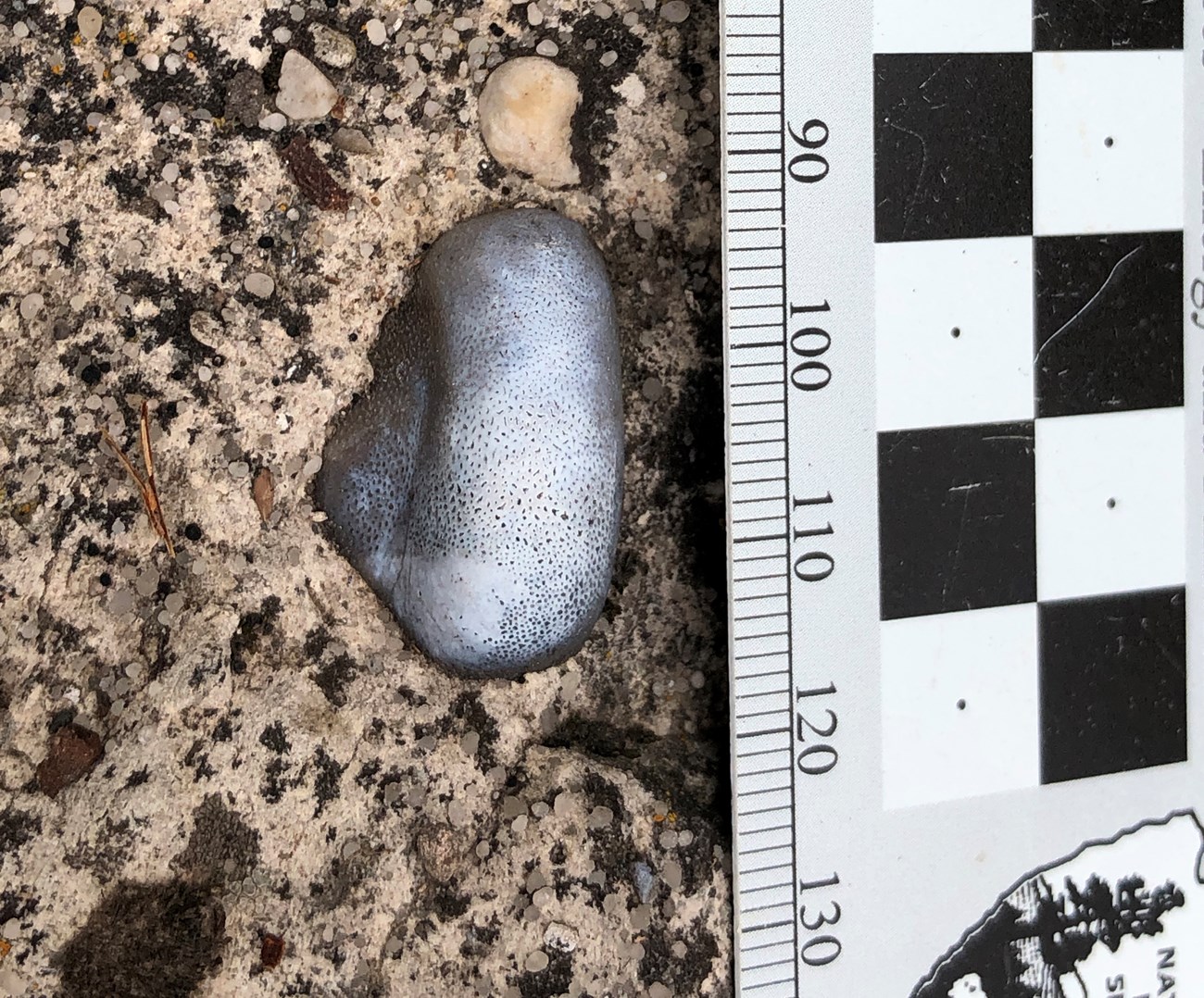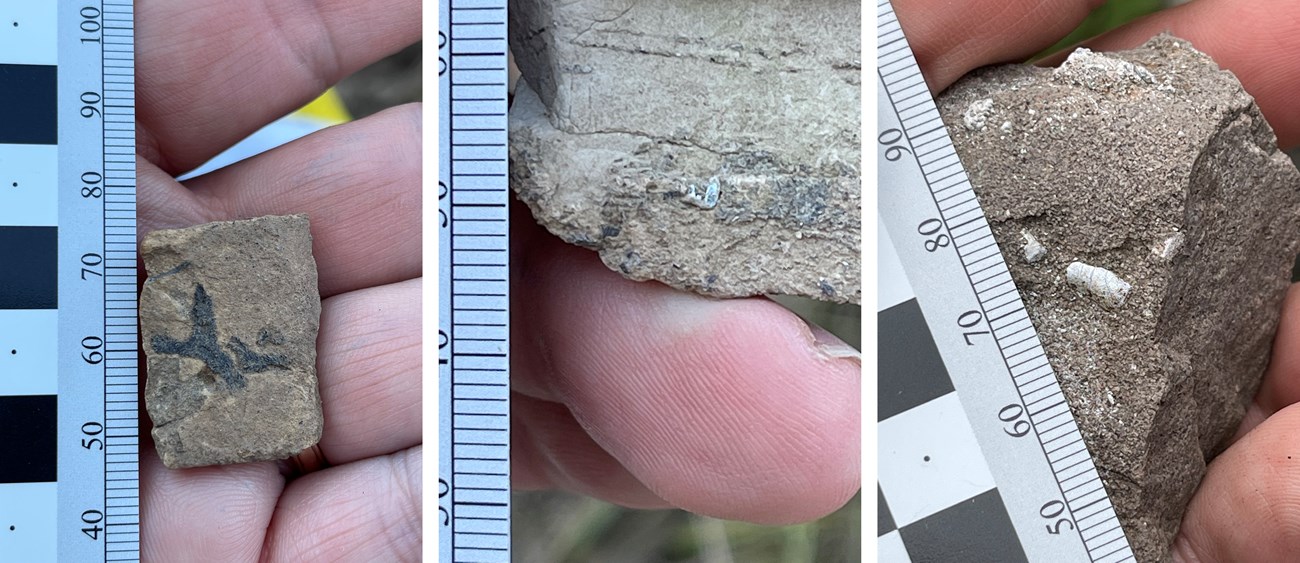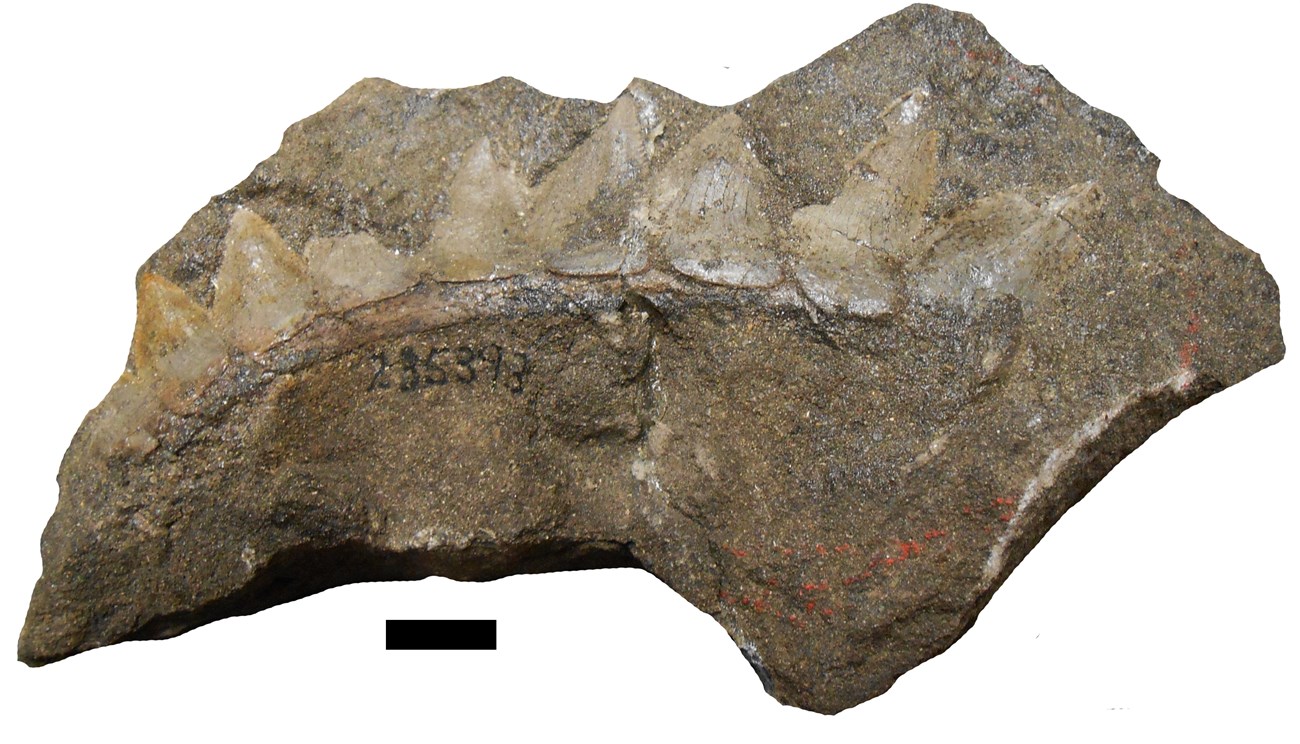Part of a series of articles titled Park Paleontology News - Vol. 14, No. 2, Fall 2022.
Article
Fossil Inventories Uncover Permian Sharks in Western National Parks

John-Paul Hodnett, Paleontologist
NPS GRD Paleontology Program, Washington D.C.; M-NCPPC Dinosaur Park, Laurel, Maryland.
Introduction
Sharks and their kin, forming the vertebrate class Chondrichthyes, have had a long and fascinating evolutionary history on our planet. Their earliest fossil evidence stretches back approximately 440 million years ago to early Silurian rocks, with some of the oldest recognized teeth found in the Early Devonian. A recent survey of the National Park Service shows records of chondrichthyan fossils from at least 46 units across the United States (Hodnett et al., 2022). Records like these demonstrate the importance of our national parks and monuments as time capsules for ancient life and the need for paleontological resource inventories (PRIs) to help the NPS understand the scope, significance, distribution, and management issues of the fossil resources that are found in our NPS units for conservation, research and public education.
Grand Canyon National Park
The first NPS PRI I participated in was back in 2019 at Grand Canyon National Park (GRCA), which coincided with the centennial celebration of the establishment of GRCA (Hodnett and Elliott, 2021). My particular project was to survey the North and South Rims of the Grand Canyon for marine vertebrate fossils in the Kaibab Limestone, which caps the rim of the canyon. The Kaibab Formation has a rich fish fossil record, which I helped identify in the Flagstaff region of Arizona as an undergrad at Northern Arizona University (Hodnett et al., 2012). The first fish fossils were found in the GRCA area early to mid-20th century with a handful of teeth and bones from both rims at the Grand Canyon (McKee, 1938). To make a long story short, we were very successful, finding two new localities on the North Rim that were rich in fish fossils. However, one specimen, a tooth plate to a holocephalan (a relative to extant “ratfish”) belonging to Crassidonta stuckernbergi stuck out from everything else we found because it had never been found in the Kaibab Limestone until that field inventory (Figure 1). Crassidonta was first described in 1916 from a couple of tooth plates found in the early Permian Phosphoria Formation from the Wind River Mountain Range in western Wyoming, and up until recently was only recognized from the Phosphoria Formation and a site in Russia (Branson, 1916; Branson 1933, 1934). This discovery raised the question: did the southern Kaibab Limestone and the northern Phosphoria Formation, both considered fairly contemporaneous and sharing the same coastal waters by geologic standards, share similar fish assemblages?

Photo by JP Hodnett.
Aside from Crassidonta, the Phosphoria Formation is very well known for its diversity of “whorl-toothed sharks” known as the eugenodonts. Eugenodonts are not true sharks, but rather a chondrichthyan taxonomic order with a closer relationship with the extant ratfish. However, this group did have a rather shark-like appearance and evolved into a number of families with various tooth types. The “whorl-toothed” moniker comes from a single tooth file at the front end of the lower jaw that either grew continuous blade-like cusps throughout the animal’s life (such as Helicoprion), or had blade-like teeth that continuously shed individual teeth (such as Edestus), or had large crushing-like teeth (such as Fadenia) (Tapanila et al., 2020). A number of Permian chondrichtyan taxa are recognized from the Phosphoria Formation, including Helicoprion (Bendix-Almgree, 1966).
However, the Kaibab Limestone has a rather poor diversity of eugenodonts, mostly known from small species with crushing teeth. On the other hand, this formation does have a rich record of ctenacanthiforms, close cousins to the modern shark lineage that had large dorsal fin spines and jaws full of teeth. During the early Permian, ctenacanths were diverse with some reaching body sizes larger than modern white sharks, while other taxa were small, reaching less than a foot in length. Currently eight species of ctenacanths are recognized in the Kaibab Limestone, but only one in the Phosphoria Formation. Much of what we know about the fish diversity in the Phosphoria comes from work that was done in the early to mid-20th century, and very few new collection surveys have been undertaken in recent years. The discovery of Crassiodonta at GRCA called for a new re-look at the Phosphoria Formation!
Fossil Sharks in Yellowstone and Grand Teton National Parks
Part of what we know about the fish faunas of the Phosphoria Formation was from a United States Geological Survey project that started in the 1950s (Sheldon, 1963). This project was conducted on behalf of the Division of Raw Materials of the U.S. Atomic Energy Commission between 1950 and 1954 with the goal of unraveling the stratigraphic problems of the Permian rocks in eastern Idaho, southern Montana, and western Wyoming. The focus of this project was to better understand the genesis of phosphate rocks and uranium. As a by-product of this project, a large amount of paleontological data was collected for biostratigraphic interpretation which included the documentation and collection of fish fossils, now residing in the Smithsonian Paleobiology Collections in Washington, D.C (Yochelson and Van Sickle, 1968). Two localities of interest yielding important fish fossils, one in Yellowstone National Park and the other from Grand Teton National Park, were identified during these surveys. These fossils were briefly mentioned in a USGS report, but these fish specimens were not further studied.
As part of the 150th anniversary of Yellowstone National Park, a comprehensive park paleontological resource inventory was planned and implemented in the park. One of the focused field crews, named the “Team Paleozoic”, was assembled to focus on Paleozoic fossils localities in Yellowstone.

Images by Vincent Santucci (left) and JP Hodnett (right).
Fossil Sharks and Relatives of Yellowstone National Park
After almost a year of planning and adjustments of those plans due to the flooding in northern Yellowstone in June of this year, we began our field surveys in the park during middle August 2022. Relocating the original 1950s USGS site was no easy task as the locality information presented in the USGS publications and on file in the Smithsonian Paleobiology records was vague. However, late on the second day the team managed to locate a steep slope with sandy limestones that matched the description of the locality from the original survey in the 1950s. The fish fossils discovered in August 2022 consisted primarily of fragments of bone and teeth in sandy limestone eroding from a small outcrop midway up the slope. The first identifiable shark fossil was found by Thom Curdts and consisted of two fragmentary ctenacanth shark teeth in matrix. Though fragmentary, the thin reclining median cusp on a thin tooth base greatly resembled the teeth of Neosaivodus from the Kaibab Limestone from Arizona (Hodnett et al., 2012).
However, within a short time after the initial discovery of this fossil shark specimen, Rod Mateo found a lump of limestone with a tiny juvenile ctenacanth tooth that was in better shape. This specimen represented Glikmanius, a fairly common ctenacanth species during the Pennsylvanian and early Permian periods, including the Kaibab Limestone. Until this discovery, Glikmanius was unknown in the Phosphoria. The next day we discovered a new locality that had early ammonoids and chondrichthyan teeth. We found a few examples of ratfish relatives, including a weathered Deltodus mercurii tooth plate and the lateral bar-like teeth to a eugenodont similar to Fadenia, which is a whorl-toothed chondrichthyan well known from the Permian of Greenland and the Early Triassic of Canada (Neilson, 1932).

Photos by JP Hodnett and Madison Mateo.
The Shark Death Bed of Grand Teton
Returning from the field for a short recovery and much needed laundry task, Max, Maddy, Rod, and I geared up again to head into the backcountry of the far northern region of Grand Teton National Park. With Sam Timko as our guide, we made our way to our survey area deep in the backcountry of the park. One of the localities we hoped to relocate was the fossil site discovered during the 1950s USGS survey that noted an “abundance of fish fossils” from the Phosphoria Formation. This locality is believed to be where a nearly complete whorl of Sinohelicoprion was collected (Figure 4). Sinohelicoprion was a eugenodont and a relative to Edestus, which previously was only known from Asia (Tapanila et al., 2020).

Photo by JP Hodnett.
When our field team reached the area where the Phosphoria Formation was exposed, the team began to identify bone fragments, tiny teeth, and scales of bony fish littering the surface of a limestone ridge (Figure 5). Spreading out, we started finding much more, including fragments of larger shark teeth and then soon more complete specimens from both the limestone ridge and the sandstone lenses just under the limestone. Tracing this limestone ridge, we soon realized that nearly the entirety of this deposit was rich in marine vertebrate fossils!

Photos by JP Hodnett.
Unfortunately, time has taken its toll on many of the exposed teeth, bones, spines, and scales we encountered, which were heavily weathered. Most of the specimens we encountered could only be identified in the field to either order or family levels, but clearly the fossil assemblage was very diverse. We did find a number of well-preserved fossil specimens for more specific identifications including the ctenacanth Glikmanius, a very large ctenacanth (possibly Kaibabvenator, known from the Kaibab Limestone), large crushing-type eugenodont teeth, large ratfish teeth, and large elements of bony fish (Figure 6). The reason for the accumulation of a large number of vertebrate fossils in a marine sediment can only be speculated, but such assemblages do exist in the fossil record. The Cretaceous Mowry Shale, which also occurs in the region, is famous for its large accumulation of fish bone and scales (Anderson and Kowallis, 2005). It’s been suggested that these fish fossil accumulations are from mass die-off events in which the remains of these fishes are then washed together in large quantities. For this locality in the Grand Teton National Park, a similar mass death event and wash-in accumulation model appears to exist in the park.

Photos by JP Hodnett.
Connecting the Permian Fossil Assemblages
Within the two-week period the field team was able to survey the Phosphoria Formation outcrops at Yellowstone and Grand Teton National Parks and were able to relocate both of the 1950s USGS fossil localities and discover new paleontological localities in the park. By combining the data from the 1950s collection and our new work from our 2022 field season, we can flesh out the Phosphoria Formation fish assemblages. They show a diverse grouping of cartilaginous and bony fishes, with many trending to larger body sizes compared to related forms seen in the older Mississippian and Pennsylvanian periods (Figure 7).
The fish fossils encountered in the western national parks are beginning to show that the Kaibab Limestone at Grand Canyon and elsewhere in northern Arizona and the Phosphoria Formation at Grand Teton and Yellowstone share specimens of at least some of their larger fish species. The recognition of ctenacanth teeth similar to Neosaivodus, possibly the apex predator Kaibabvenator, and the first definitive record of Glikmanius in the Phosphoria, tie with those seen in the Kaibab Limestone. Large holocephalan tooth plates and giant tooth plates of deep-bodied platysomid fishes have also been found in both assemblages as well. Further work is needed in both the field and lab to tell a more detailed account of how these northern and southern assemblages are related to one another. However, this initial work shows there is great potential for more discoveries to come!

Figure 7. A visual representation of the Phosphoria Fish Assemblage found at Yellowstone and Grand Teton National Parks based on the 1950s USGS and the 2022 NPS paleontological resource field inventories. Fishes are drawn in approximate scale of a 5’10” male human. Orange colorations represent the Elasmobranchii (sharks and rays) subclass (light orange, Ctenacanthiformes; dark orange, Hybodontiformes), blue coloration the Euchondrocephali (ratfish and kin) subclass (dark blue, Eugenodontiformes; blue, Orodontiformes; light blue, Petalodontiformes; teal blue, Holocephali), and green Class Osteichthyes/subclass Actinopterygii (bony ray-finned fishes).
Illustration by JP Hodnett.
References
-
Anderson, A.D. and Kowallis, B.J. 2005. Storm deposited fish debris in the Cretaceous Mowry Shale near Vernal Utah, in Dehler, C.M., Pederson, J.L., Sprinkle, D.A., and Kowallis, B.J. eds. Uinta Mountain geology: Utah Geological Association Publication 33, p. 125-130.
-
Bendix-Almgree, S.E. 1966. New investigations of Helicoprion from the Phosphoria Formation of South-East Idaho, U.S.A. Biologiske Skrifter Det Kongelige Danske Videnskabernes Selskab 14(5): 3-54.
-
Branson, C.C. 1933. Fish fauna of the middle Phosphoria Formation. The Journal of Geology 41(2): 174-183.
-
Branson, C.C. 1934. Permian sharks of Wyoming and East Greenland. Science 79(2954): 431.
-
Branson, E.B. 1916. The Lower Embar of Wyoming and its fauna. The Journal of Geology 24(7): 639-664.
-
Hodnett, J.P., Elliott, D.K., Olson, T.J., and Wittke, J.H. 2012. Ctenacanthiform sharks from the Permian Kaibab Formation, northern Arizona. Historical Biology 24(4): 381-395.
-
Hodnett, J.P and Elliott, D.K. 2020. Paleozoic Vertebrate Paleontology of Grand Canyon National Park: Research History, Resources, and Potential. In Santucci, V. L. and Tweet, J.S. Eds Grand Canyon National Park Centennial Paleontontological Resources Inventory a Centrury of Fossil Discovery and Research. Utah Geolgoical Associational Special Publication 1: 105-118.
-
Hodnett, J.P., Tweet, J.S., and Santucci, V.L. 2022. The occurrence of fossil cartilaginous fishes (Chondrichthyes) within the parks and monuments of the National Park Service. New Mexico Museum of Natural History and Science Bulletin 90: 183-208.
-
McKee. E.D. 1938. The environment and history of the Toroweap and Kaibab Formations of northern Arizona and southern Utah. Carnegie Insitution of Washington Publication 492: 268 pp.
-
Neilson, E. 1932. Permo-Carboniferous Fishes from East Greenland. Meddlelser Om Gronland 86(3): 5-63.
-
Sheldon, R.P. 1963. Physical stratigraphy and mineral resources of Permian rocks in western Wyoming. Geologic Survey Professional Paper 313-B: 49-273.
-
Tapanila, L., Pruitt, J., Wilga, C.D., and Pradel, A. 2020. Saws, scissors and sharks: Late Paleozoic experimentation with symphyseal dentition. The Anatomical Record 303: 363-376.
Related Links
-
Grand Canyon National Park, Arizona—[Geodiversity Atlas] [Park Home] [npshistory.com]
-
Grand Teton National Park, Wyoming—[Geodiversity Atlas] [Type Section Inventory] [Park Home] [npshistory.com]
-
Yellowstone National Park, Idaho, Montana, and Wyoming—[Geodiversity Atlas] [Type Section Inventory] [Park Home] [npshistory.com]
Last updated: April 19, 2023
